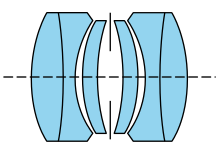Plasma
The Plasmat is a high-performance lens developed by Paul Rudolph from 1918 and in the 1920s for the Hugo Meyer company (" Meyer-Optik "), Görlitz.
The Plasmat goes back to the so-called Dagor lens type. The Dagor was a six-lens double anastigmat from Goerz , Berlin. The Dagor consists of two three- lens cemented lens groups that are arranged symmetrically around the diaphragm. With otherwise good optical performance, however, a considerable spherical aberration remained . The separation of the two inner lenses from the two cemented lens groups resulted in additional degrees of freedom for correcting this optical aberration . Paul Rudolph implemented this construction principle particularly successfully with the Plasmat. The immediate predecessor of the Plasmat was the Euryplan 1: 6 calculated by Ernst Arbeit . First built by Schulze & Billerbeck, later also by Hugo Meyer. From this, Rudolph first developed the (double) plasma with a light intensity of almost 1: 4.
The plasma essentially consists of two opposing doublets, each of which is assigned a further curved converging lens (meniscus) on the inside . There is an air gap between the doublets and the menisci; the diaphragm between the menisci. Instead of the Dagor's four glass-air surfaces, the Plasmat has eight such surfaces. Since the coating of optical surfaces had not yet been invented in the 1920s, the plasma was susceptible to internal reflections .
The first so-called double or set plasma had a maximum light intensity of 1: 4.5. In addition to their use in "normal" photography, plasmates were often used in devices for copying documents.
Rudolph achieved an important further development in 1922. Inspired by the particularly high light intensity required by film cameras , he constructed the Plasmat cinema . Here the two inner lenses were bent the other way around and the front doublet was enlarged. This enabled luminous intensities of 1: 2 (1924) and finally 1: 1.5 (1926) to be achieved. Back then, these were the fastest photographic lenses in the world.
The London camera company AO Roth marketed a "Meyer Speed Camera" (4.5 cm × 6 cm) in the mid-late 1920s, which was equipped with a 1: 2/90 mm Kino Plasmat. Due to the high light intensity, the lens was also used scientifically. In the early 1930s, for example, a 1: 1.5 / 50 mm cinema plasmat was used for the photographic and spectrographic examination of the northern lights. There are also variants that can be used as projection lenses (see picture).
Individual evidence
- ^ Rudolf Kingslake: A History of the Photographic Lens. Academic Press, 1989, p. 95
- ↑ Compendium of Photography, Prof. Fritz Schmidt, 14th edition 1922
- ↑ a b Early bright lenses for 35mm and other small picture formats
- ^ Rudolf Kingslake: A History of the Photographic Lens. Academic Press, 1989, p. 96
- ↑ Earlyphotography.co.uk , accessed 19 August 2011
- ↑ Leiv Harang: Filter recordings of aurora borealis. In: Geofysiske Publishers. Volume 10, No. 8, 1933, pp. 5–25 ( PDF file ; 6.2 MB, accessed on August 16, 2011)




